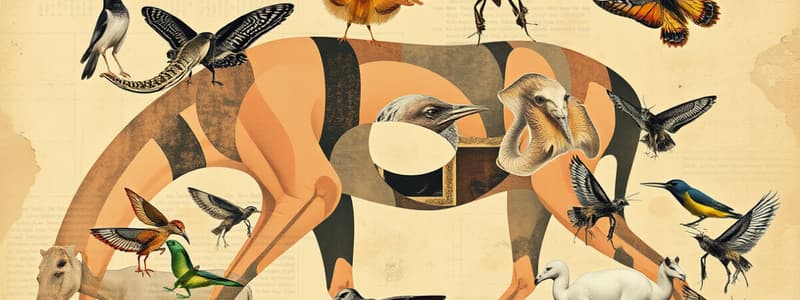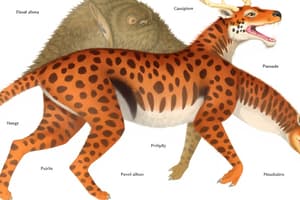Podcast
Questions and Answers
Which of the following phyla lacks true tissues and organs?
Which of the following phyla lacks true tissues and organs?
- Porifera (correct)
- Platyhelminthes
- Annelida
- Cnidaria
Which characteristic is NOT true for the phylum Arthropoda?
Which characteristic is NOT true for the phylum Arthropoda?
- They have exoskeletons made of chitin.
- Their bodies are segmented.
- They possess a water vascular system. (correct)
- They include insects, arachnids, and crustaceans.
Which term best describes animals that show two identical halves?
Which term best describes animals that show two identical halves?
- Asymmetry
- Radial Symmetry
- Segmented Symmetry
- Bilateralsymmetry (correct)
What type of body symmetry is found in organisms of the phylum Cnidaria?
What type of body symmetry is found in organisms of the phylum Cnidaria?
Which of the following statements about Nematoda is TRUE?
Which of the following statements about Nematoda is TRUE?
In which level of body organization do organisms display true tissues?
In which level of body organization do organisms display true tissues?
Which phylum is known for including organisms with a notochord at some stage of their life cycle?
Which phylum is known for including organisms with a notochord at some stage of their life cycle?
What type of reproductive strategy involves the creation of genetically identical offspring without fertilization?
What type of reproductive strategy involves the creation of genetically identical offspring without fertilization?
Which structure is specifically associated with chordates and serves as a flexible support?
Which structure is specifically associated with chordates and serves as a flexible support?
Why is studying the animal kingdom important in ecological contexts?
Why is studying the animal kingdom important in ecological contexts?
Study Notes
Animal Kingdom Overview
- The animal kingdom, known as Animalia, is a diverse group of multicellular organisms.
- Animals are heterotrophic, requiring organic compounds for nutrition.
- They exhibit various forms of locomotion, have specialized sensory organs, and show complex behaviors.
Classification of Animals
-
Kingdom Animalia
- Subdivided into multiple phyla based on structural and functional characteristics.
-
Major Phyla in the Animal Kingdom:
-
Porifera (Sponges):
- Simple, multicellular organisms.
- Lack true tissues and organs.
- Filter feeders using a porous body structure.
-
Cnidaria:
- Includes jellyfish, corals, and sea anemones.
- Have radial symmetry and specialized stinging cells (cnidocytes).
- Two body forms: polyp and medusa.
-
Platyhelminthes (Flatworms):
- Bilaterally symmetrical; have a flattened body.
- Include free-living (e.g., planarians) and parasitic forms (e.g., tapeworms).
-
Nematoda (Roundworms):
- Cylindrical, elongated bodies with a complete digestive system.
- Can be free-living or parasitic.
-
Annelida (Segmented Worms):
- Body divided into segments (metamerism).
- Includes earthworms and leeches.
-
Arthropoda:
- Largest phylum; includes insects, arachnids, and crustaceans.
- Characterized by segmented bodies, exoskeleton made of chitin, and jointed appendages.
-
Mollusca:
- Diverse group including snails, clams, and octopuses.
- Typically have a soft body, often with a hard shell.
- Exhibit a muscular foot and a mantle.
-
Echinodermata:
- Marine animals like starfish and sea urchins.
- Have a unique water vascular system and radial symmetry in adults.
-
Chordata:
- Animals with a notochord, dorsal nerve chord, pharyngeal slits, and post-anal tail.
- Includes vertebrates (fish, amphibians, reptiles, birds, mammals) and some invertebrates (lancelets, tunicates).
-
Characteristics of Animals
-
Symmetry:
- Bilateral: Two identical halves (e.g., humans).
- Radial: Multiple symmetrical parts around a central axis (e.g., jellyfish).
- Asymmetrical: No symmetry (e.g., sponges).
-
Body Organization Levels:
- Cellular: No true tissues (e.g., sponges).
- Tissue: Organized into tissues (e.g., cnidarians).
- Organ: Organized into organs (e.g., annelids).
- Organ System: Organized into systems (e.g., vertebrates).
-
Reproductive Strategies:
- Asexual: Budding, fragmentation, regeneration.
- Sexual: Fertilization can be external or internal.
Key Terms
- Heterotrophic: Organisms that obtain food by consuming other organisms.
- Metamerism: Division of the body into repeated segments.
- Chitin: A polysaccharide that forms the exoskeleton of arthropods.
- Notochord: A flexible rod-like structure found in chordates.
Importance of Study
- Understanding the animal kingdom is crucial for ecology, conservation, and evolutionary biology.
- Animals play vital roles in ecosystems as consumers, pollinators, and decomposers.
Animal Kingdom Overview
- The animal kingdom, called Animalia, consists of varied multicellular organisms.
- Animals are heterotrophic, requiring organic materials for nutrition.
- Features include diverse locomotive abilities, specialized sensory organs, and complex behaviors.
Classification of Animals
- Kingdom Animalia is divided into several phyla based on structural and functional traits.
- Porifera (Sponges):
- Simple multicellular organisms lacking true tissues and organs.
- Function as filter feeders through a porous structure.
- Cnidaria:
- Comprises jellyfish, corals, and sea anemones.
- Exhibit radial symmetry and possess specialized cnidocytes for stinging.
- Two body forms: polyp (attached) and medusa (free-swimming).
- Platyhelminthes (Flatworms):
- Characterized by bilateral symmetry and a flattened body.
- Encompasses both free-living (e.g., planarians) and parasitic (e.g., tapeworms) species.
- Nematoda (Roundworms):
- Cylindrical body structure with a complete digestive system.
- Includes free-living and parasitic varieties.
- Annelida (Segmented Worms):
- Body organized into segments (metamerism).
- Contains organisms such as earthworms and leeches.
- Arthropoda:
- The largest phylum, comprising insects, arachnids, and crustaceans.
- Features segmented bodies, chitinous exoskeletons, and jointed appendages.
- Mollusca:
- A diverse group including snails, clams, and octopuses.
- Typically have soft bodies, often protected by hard shells, and possess a muscular foot and mantle.
- Echinodermata:
- Marine animals such as starfish and sea urchins.
- Possess a unique water vascular system and exhibit radial symmetry as adults.
- Chordata:
- Characterized by a notochord, dorsal nerve chord, pharyngeal slits, and post-anal tail.
- Groups include vertebrates (fish, amphibians, reptiles, birds, mammals) and invertebrates (lancelets, tunicates).
Characteristics of Animals
- Symmetry Types:
- Bilateral symmetry: Two mirror-image halves (e.g., humans).
- Radial symmetry: Multiple symmetrical parts around a central axis (e.g., jellyfish).
- Asymmetry: Lack of symmetry (e.g., sponges).
- Levels of Body Organization:
- Cellular: No true tissues (e.g., sponges).
- Tissue: Organized into distinct tissues (e.g., cnidarians).
- Organ: More complex structures (e.g., annelids).
- Organ System: Advanced organization into systems (e.g., vertebrates).
- Reproductive Strategies:
- Asexual reproduction through budding, fragmentation, or regeneration.
- Sexual reproduction with external or internal fertilization.
Key Terms
- Heterotrophic: Organisms that derive nutrition by consuming other living entities.
- Metamerism: Division of the body into repeated segments.
- Chitin: A polysaccharide composing the exoskeleton of arthropods.
- Notochord: A flexible rod-like structure present in chordates.
Importance of Study
- Studying the animal kingdom is essential for understanding ecology, conservation efforts, and evolutionary dynamics.
- Animals contribute significantly to ecosystems, acting as consumers, pollinators, and decomposers.
Studying That Suits You
Use AI to generate personalized quizzes and flashcards to suit your learning preferences.
Description
Explore the diverse world of the animal kingdom, known as Animalia. This quiz covers essential classifications, including major phyla like Porifera, Cnidaria, and Platyhelminthes, highlighting their unique characteristics and behaviors. Test your knowledge on the structural and functional traits that define this vibrant group of organisms.



